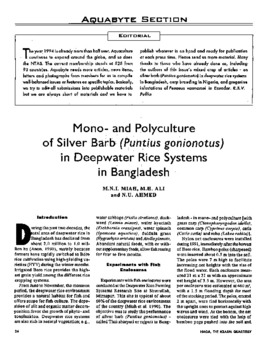Mono-and polyculture of silver barb (Puntius gonionotus) in deepwater rice systems in Bangladesh

Citation
Miah, M.N.I.; Ali, M.H.; Ahmed, N.U. (1994). Mono-and polyculture of silver barb (Puntius gonionotus) in deepwater rice systems in Bangladesh. NAGA 17 (3): 26-27
Experiments with fish enclosures were conducted at the Deepwater Rice Farming Systems Research Site at Shuvullah, Mirzapur, Bangladesh. The objective was to study the performance of silver barb (Puntius gonionotus) called Thai sharputi or rajputi in Bangladesh in mono-and-polyculture with grass carp (Ctenopharyngodon idella), common carp (Cyprinus carpio), catla (Catla catla) and rohu (Labeo rohita). Each enclosure measured 21 m x 21 m with an approximate net height of 3.5 m. The stocking densities per cubic meter were 1 fingerling for Thai sharputi monoculture (enclosure 1), and 2 fingerlings for the polyculture systems (enclosure 2 and 3). The species ratio for enclosure 2 was 0.37:0.27:0.02:0.34 (grass carp:Thai sharputi:common carp:catla) and for enclosure 3, 0.4:0.4:0.2 (catla:rohu:Thai sharputi). In monoculture (enclosure 1), Thai sharputi performed well. This relatively good production was mainly attributed to the use of appropriately sized fingerlings and rapid growth from consumption of an abundant supply of azolla in addition to feed given. For the polyculture in enclosure 2, the average weight gain of common carp was the highest (673 g) followed by grass carp (475 g) and Thai sharputi (286 g). For the polyculture in enclosure 3, the length and weight gains for Thai sharputi were almost the same as for the monoculture.
Permalink
Date Available
Type
Publisher
Countries
Copyright
CC BY 4.0
Research Themes
Topics
Language